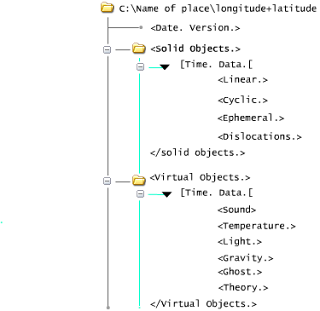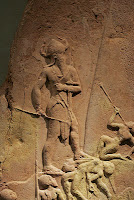Easter seems about right...
Trying to simplify.
I forgot to put -Compass bearing at the top, oh well!
Surely it is an easy matter to find latitude and longitude?
Yes:
Woodhenge -Latitude: 51.189413N Longitude: 1.786029W
The Sanctuary -Latitude: 51.410002N Longitude: 1.83173W
Linear and cyclic refer to time.
Linear time is the arrow of time, moving ever onwards. All solid object in a location for longer than one year or more, are recorded.
Cyclic time refers to objects that reappear at the same point in the earth's rotation: the annual position of the sun, the 19. something moon cycle as seen from earth.
Ephemeral refers to objects just blowing through...myself included.
Dislocations are objects from a site that are dislocated; placed elsewhere (usually a museum).
Virtual objects are 'noclip', cannot be directly handled, they can be recorded only through the intermediary of a device: sound and light by video, light meter or camera, and microphone.
Temperature is both real and subjective, a thermometer and how a place feels.
Questions arise: how does one measure gravity?
And what exactly is it that deflects dowsing rods?
Gravity in its true, scientific sense can be measured with a pendulum: here is how to do it: [LINK]. This is not a terribly practical thing to do, all I need is a pendulum made from washers, a ring stand, string, a spring clamp, 2 small pieces of wood, and a protractor.But it is interesting that it is considered fairly accurate!
I am guessing but perhaps we are more sensitive to gravity, and the sensations of underlying fault lines, cracks and anomalous densities than we know?
Magnetism too.
But magnetism is weird, I'd never asked myself before just why exactly North is North; I supposed that it was all to do with the iron core of the earth.
But now I'm not so sure.
About anything, really!
Compared to magnetism and gravity, the subject of ghosts is easy-peasy. Ghosts are experienced and not measured. Ghosts are anomalous phenomenon. I'm happy to leave it at that!
Finally, theory. Theory provides numerous narratives through which information is subdivided, filtered and perceived. The best thing is, theory is plural; there is never just one theory per place.
So, Easter -when Christ followed Adonis, followed Tammuz, followed Damuzi...Persephone's brother, Persephone's husband...is just about the right time to finish The Bronze Age part of this investigation. But only if I don't think too much about it!
The Cambridge Ritualists simplified matters by considering there to be just one god of vegetation:
The oldest version of this myth is "The Descent of Inanna" in which the Goddess 'turns her ear to the great below' and is killed by her sister, Ereshkigal. Inanna escapes, but only because her husband takes her place. As Inanna mourns for her husband and crops begin to die, her brother's sister offers to take his place in the underworld for half the year: Gehtinanna is Lady of the Vine.
Damuzi is the spring offering, whilst Geshtinanna dies in the autumn...
But I have a family and commitments and time is passing plus the Iron Age is calling me. I've been stuck with Woodhenge and The Sanctuary for quite a while, time to finish that section tomorrow.



